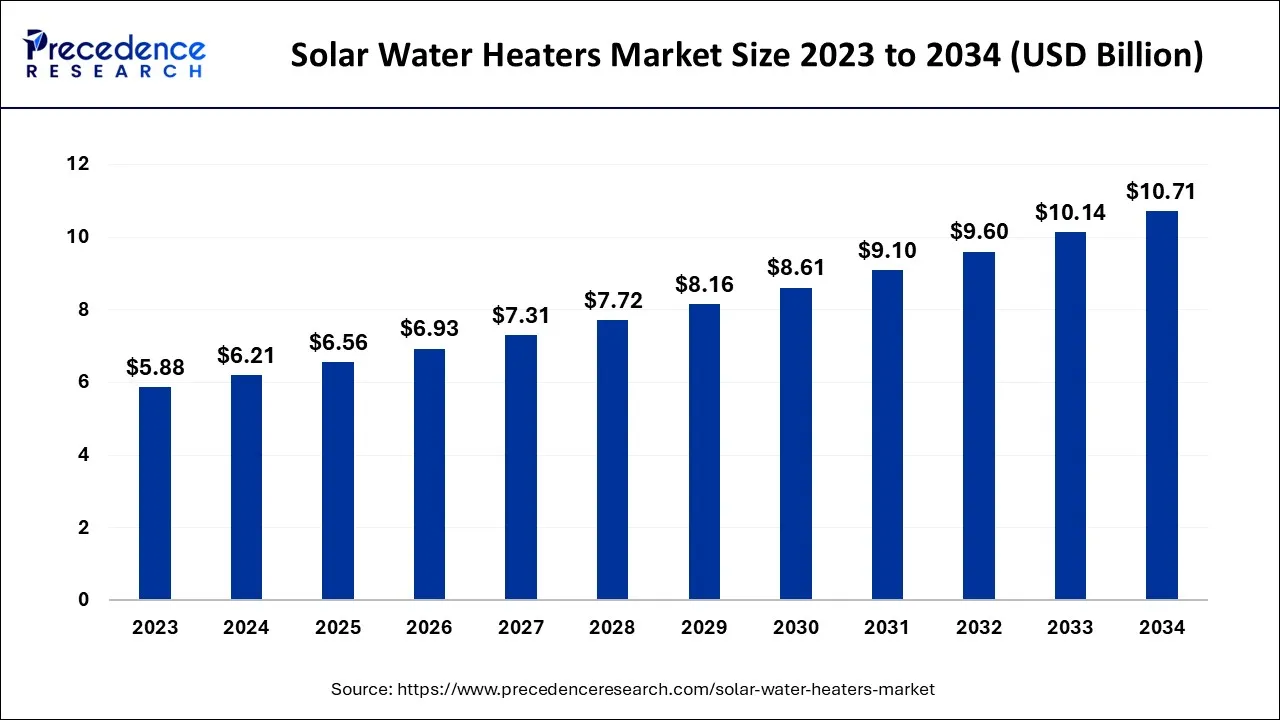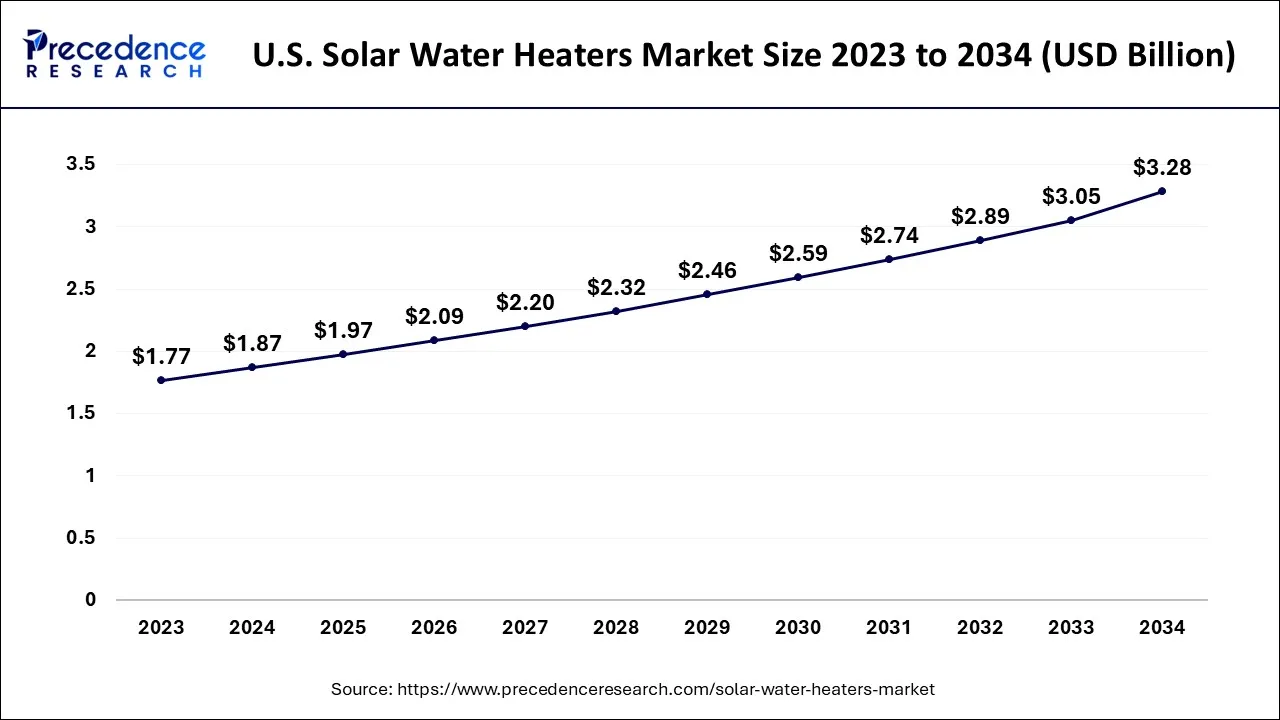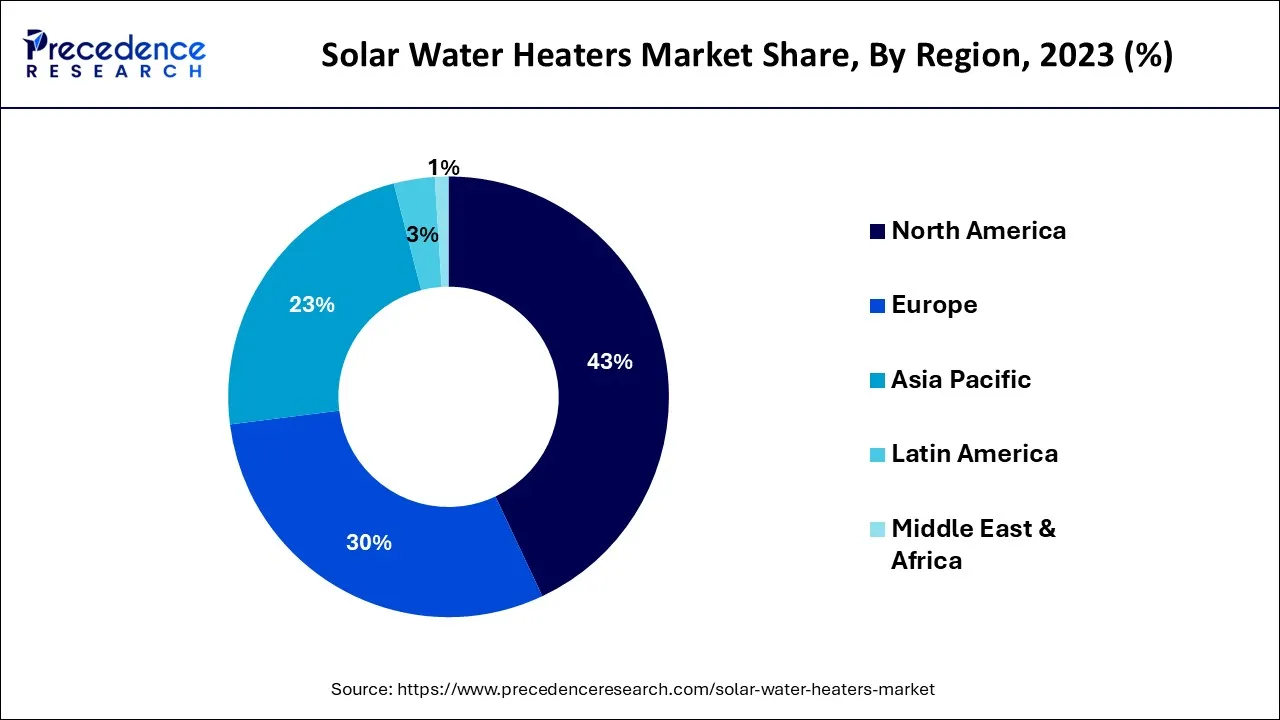List of Contents
Solar Water Heaters Market Size and Forecast 2024 to 2034
The global solar water heaters market size is worth around USD 6.21 billion in 2024 and is anticipated to reach around USD 10.71 billion by 2034, growing at a CAGR of 5.6% over the forecast period from 2024 to 2034.

Solar Water Heaters Market Key Takeaways
- North America led the global market with the highest market share of 43% in 2023.
- By collector, the flat plate collectors segment residential the biggest market share in 2023.
- By system, the thermosiphon segment has held the highest market share in 2023.
U.S. Solar Water Heaters Market Size and Growth 2024 to 2034
The U.S. solar water heaters market size accounted for USD 1.87 billion in 2024 and is projected to be worth around USD 3.28 billion by 2034, poised to grow at a CAGR of 5.8% from 2024 to 2034.

The United States market will grow as a result of constant investments in infrastructure for single and multi-family homes supported by growing purchasing power and expanding urbanization. Furthermore, the industry landscape will be improved by supportive government initiatives to encourage the use of solar technology and strict restrictions to lower carbon emissions. The continued transition toward the use of clean and renewable energy sources and technological advancement to attain energy efficiency at a cheap cost are a few variables that will affect the size of the Indian market.

Due to rising demand for water heating solutions in both commercial and residential settings as well as rising living standards, the German market will expand. The OECD estimates that in 2016, 15% of all domestic energy consumption was used for water heating. Increasing emphasis on reducing import dependence and higher taxes on fossil fuels are two important factors that have a beneficial impact on product uptake. The market for solar water heaters in South Africa will expand as a result of rising solar technology adoption in residential buildings and escalating need for energy-efficient systems to take the place of high-pressure electric systems.
Market Overview
Solar water heaters are electrical devices that help heat water for both domestic and commercial usage. In contrast to traditional warmers, solar water heaters run on solar power. Solar thermal energy that is harvested from the sun is used to heat water, which flows through a solar water heater.
Solar Water Heaters Market Growth Factors
The global solar water heater market size will be driven by rising demand for eco-friendly, dependable, and affordable technology for water heating solutions across residential and non-residential sectors. In comparison to traditional heating systems, the solar water heater has the capacity to provide low operating costs, or 25% to 40% in winter and 75% in summer. The demand for energy-efficient solutions is being driven by a growing understanding of how to use sustainable technologies effectively and rising infrastructure expenditure. The implementation of incentives like tax breaks, subsidies, and tax credits will also help to promote the use of sustainable technology, which will improve the outlook for the company. The need for energy-efficient water heaters is anticipated to expand every year as a result of the increasing depletion of non-renewable resources, together with greater efforts to control energy use. This should accelerate market growth during the timeframe of the projection. In order to appeal to a wider spectrum of clients, regardless of their financial status, these systems are priced inexpensively. It is anticipated that greater environmental awareness would spur industry expansion in both developed and emerging countries.
Market growth is anticipated to be fueled by rising demand for reliable, affordable, and environmentally friendly water heating technologies, notably in the residential and industrial sectors. It is anticipated that the system's capacity to operate at reduced costs—up to 75% cheaper in the summer and 30% to 40% lower in the winter—will encourage consumers to choose it over competing goods already on the market. For the installation of solar water heating systems, governments all over the world offer rebates and incentives. For instance, depending on the kind and size of the installed system, reimbursements of up to $700 are possible in Victoria, Australia's residential and commercial districts. On the other hand, solar water heating requires a large roof area and exposure to direct sunlight because it could not function on overcast or foggy days. However, improvements in backup energy systems that function even on cloudy days are anticipated to create profitable economic opportunities.
- The global market for solar water heaters is expanding as a result of the solar water heater's energy efficiency and lower energy usage.
- As fossil fuels are predicted to run out in the future, there is a growing demand for alternative energy sources for the electricity grid.
- It's predicted that the market would expand as a consequence of sizable expenditures made by industry players in the solar water heater sector over the course of the forecasted period.
- Growing need for cost-effective, dependable, and green water heating solutions, particularly in the residential and commercial sectors.
Market Scope
| Report Coverage | Details |
| Market Size in 2024 | USD 6.21 Billion |
| Market Size by 2034 | USD 10.71 Billion |
| Growth Rate from 2024 to 2034 | CAGR of 5.6% |
| Base Year | 2023 |
| Forecast Period | 2024 to 2034 |
| Segments Covered | Collector, System, Application, and Region |
| Regions Covered | North America, Europe, Asia-Pacific, Latin America and Middle East & Africa |
Market Dynamics
Key Market Drivers
- The need for environmentally friendly and energy-efficient heating systems - The increasing demand for ecological and energy-efficient heating options is driving the global market for solar water heaters. Solar water heaters are reported to be significantly more energy-efficient than conventional water heaters. According to research by the IEA, the overheads of solar water heaters are anticipated to be between 25 and 50 percent cheaper than those of conventional water heaters (International Energy Agency). Due to their zero carbon emission rate, solar water heater demand is expected to rise in the approaching years. Solar water heaters are compelling the industry to replace conventional water heaters, in accordance with the "Kyoto Protocol," which was agreed upon by governments from all over the globe and limits carbon dioxide emissions out of each nation's industrial and commercial zones. Due to their energy and cost-effectiveness, solar water heaters are being adopted and utilized for household purposes in more residences.
Key Market Challenges
- In less developed areas, there is less knowledge regarding solar water heaters - The failure to encourage and extend the use of renewable energy, particularly solar power systems, results in a lack of consumer understanding of its economical and environmental advantages. Given that solar power systems are a relatively new technology, consumers lack basic knowledge about them. For instance, given the short amount of daylight, some consumers may believe that renewable energy solutions are unstable. They might not be aware that intermittent technologies, when used in conjunction with other solutions like hybrid PV/thermal, are just as dependable as traditional ones. Additionally, public & private electricity suppliers might not be aware of the advantages that solar power technology systems can supply. Therefore, a significant market barrier is the lack of consumer comprehension of the advantages of embracing solar power.
Key Market Opportunities
- Support offered by the government - The market expansion for solar water heaters is also being boosted by the assistance provided by international governments and governmental organizations. The government is required to encourage and promote less carbon emission systems and devices due to the carbon limit that has been assigned to each nation. The demand for solar water heaters for industrial applications is rising as a result of government policies and laws forcing businesses and manufacturing facilities to cut their carbon emissions. The government's funding of innovative projects and research into renewable energy sources is also boosting the market for solar-powered tools and appliances and boosting demand for solar water heaters.
Collector Insights
In 2023, installations of flat plate collectors made up more than 71% of the solar water market heaters worldwide. During the projected period, the flat plate collectors (FPC) market is anticipated to expand significantly at a CAGR of 6.5%. One of the essential elements that will help these devices gain popularity is their straightforward design, which is paired with a low price and ease of installation and usage. FPC units are highly wanted in the smaller business and residential sectors. Such collectors are suitable for home and SMEs installations. Cost efficiency, straightforward design, and easy installation are critical factors for the product. Additionally, continual technical advancements in collector design that aim to increase efficiency will encourage the spread of the product.
The evacuated tube collectors market will increase as a result of the rising need for hot water distribution systems in industrial and commercial buildings that are energy efficient. Fewer space requirements, high conversion efficiency, and low maintenance costs are some of the key qualities that will promote product acceptance. The product will be preferred above alternatives because of its capacity to considerably limit the loss of heat to the surrounding environment, whether by convection or radiation.
System Insights
Due to their low space requirements, thermosiphon solar water heaters are suitable for hot climates in countries like Australia, Japan, Israel, and India. This will propel the industry's expansion. The capability to circulate flammable liquids as well as gases in heating and cooling applications without the need for mechanical pumps would further improve the market environment.
In 2018, the pumped installations made up over 30 percent of the global market. Some of the key advantages that will promote product acceptance are ease of system connection, and reduced heat loss.
Application Insights
The assistance of public and private financial institutions for the creation of infrastructures, such as governmental offices, educational institutions, and retail centers, will increase product uptake. By promoting the adoption of green technology and reducing carbon emissions, green building norms and standards will further improve the business environment.
Due to expanding investments in building repair and remodeling as well as rising disposable income, the market for solar water heaters in residential areas will develop. Due to its capacity to interact with traditional units in both newly established and existing organizations, its adoption is favored above those of its rivals. Increased awareness of energy savings and the rising need to replace old systems will further boost product uptake.
Solar Water Heaters Market Companies
- Azure Power India
- Central Electronics
- Chemtrols Solar
- Euro Multivision
- Indosolar
- Jupiter Solar Power
- Lanco Solar Private
- Mahindra Solar One
- Moser Baer Photovoltaic
- Photon Energy Systems
- PLG Power
- Surana Ventures
- Tata Power Solar Systems
- Vikram Solar
- Websol Energy System
- XL Energy
- SunTank
- A.O. Smith
- Alternate Energy Technologies
- Rheem manufacturing
- Viessmann
- Wagner Solar
Recent Developments
- A scalable water series for the commercial market was introduced by SunEarth and Nyle Water Heating System in January 2022. SunEarth's scalable Solar Series Heat Pump Water Heater may give up to a 90% decrease in system operation cost over conventional water heating systems by utilizing solar water heating and heat pump efficiency.
- Gujarat had a more than two-fold increase in yearly solar water heater installations between March 2018 and March 2020, going from 1,00,000 square meters to 2,53,000 square meters (m2). Currently, 19.84% of India's anticipated 12,75,000 installations in 2019 were in Gujarat. Five years ago, the state's market share was under 10%.
Segment Covered in the Report
By Collector
- Evacuated tube collector
- Flat Plat collector
- Unglazed water collector
By System
- Thermo siphon
- Pumped
By Application
- Educational Institutes
- Offices
- Government
- Others
By Geography
- North America
- Europe
- Asia-Pacific
- Latin America
- Middle East & Africa (MEA)
For inquiries regarding discounts, bulk purchases, or customization requests, please contact us at sales@precedenceresearch.com
Frequently Asked Questions
Ask For Sample
No cookie-cutter, only authentic analysis – take the 1st step to become a Precedence Research client